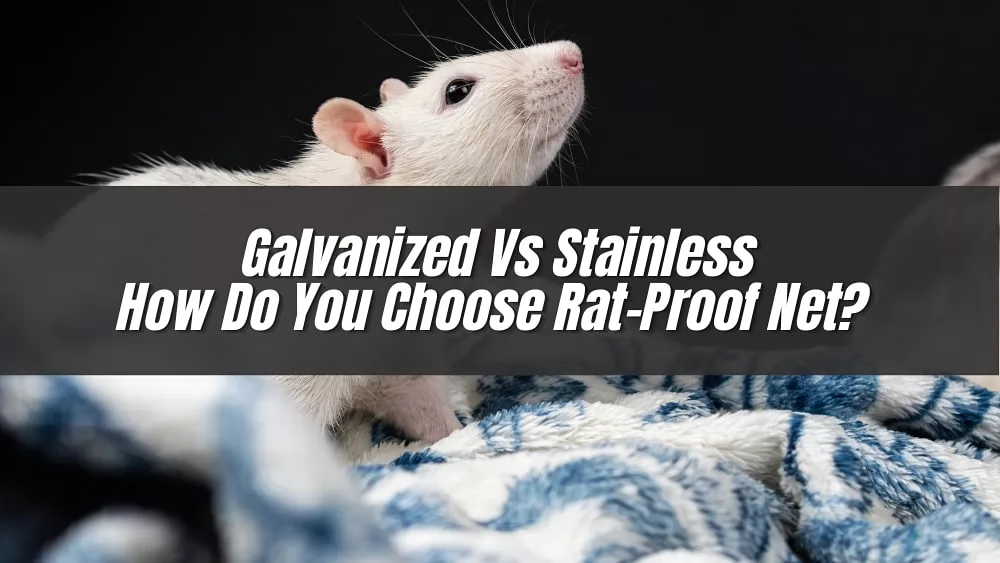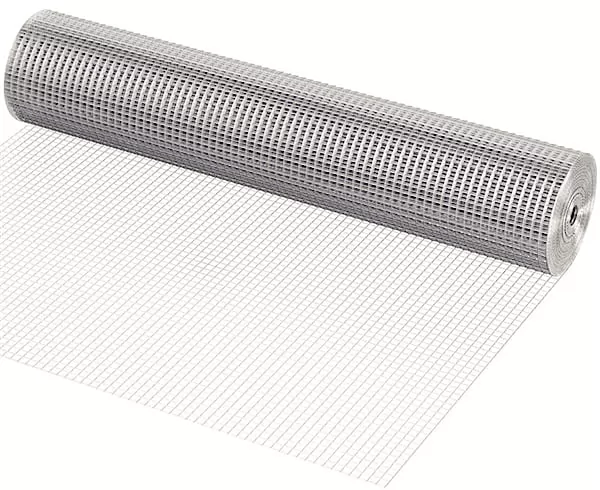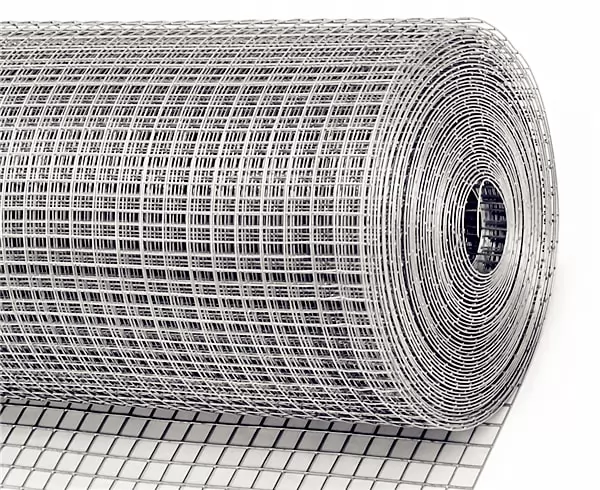





Choosing the right rodent-proof mesh is a crucial step in protecting your home, warehouse, or commercial space from rodent infestation. Whether you're considering the economical and practical galvanized rodent mesh or the more corrosion-resistant and durable stainless steel rodent mesh, it's important to understand the characteristics and application scenarios of each material.
Galvanized rodent-proof mesh offers excellent rust resistance and a cost-effective price-performance ratio, making it suitable for most indoor or dry environments. Stainless steel rodent-proof mesh, on the other hand, is ideal for wet, exposed areas due to its superior corrosion resistance and extended lifespan.
Let's take a closer look at the differences between these two rodent mesh types in terms of rodent deterrent effectiveness, durability, and installation scenarios to help you make the most informed choice.
For more price information, you can check the current market “welded wire mesh price”
Galvanized rodent-proof mesh is a metal protective mesh made from low-carbon steel wire, hot-dip or electroplated with zinc. It is designed to deter intrusion by rodents such as mice and voles. Its moderate mesh size effectively prevents small pests from passing through while maintaining good ventilation and visibility.
Unlike stainless steel rodent-proof mesh, galvanized rodent-proof mesh relies primarily on a zinc coating for corrosion resistance. While its overall rust resistance is not as good as stainless steel, it remains an economical and practical choice for dry or semi-outdoor environments.
Galvanized mesh is suitable for both home rodent control and widespread use in farms, warehouses, garages, gardens, and other areas. It is a cost-effective rodent-proof mesh solution.

1. A Cost-Effective Choice:
Galvanized rodent mesh is lower in cost than stainless steel, making it ideal for budget-constrained users who need to implement extensive rodent-proofing measures, such as in farm greenhouses, food storage areas, and livestock farms.
2. Sturdy Construction and Easy Installation:
This type of mouse wire mesh typically features a cross-welded or woven structure, maintaining its overall strength even after repeated bending or cutting. It can be easily cut to size and flexibly installed in common rodent-invasion points, such as door cracks, vents, and drains.
3. Effective Rodent-Proofing:
Galvanized material is highly resistant to rodent bites, effectively preventing them from burrowing or damaging other structures to enter a home. When properly laid out, it creates a robust, rat-proof wire mesh barrier.
4. Various Specifications Available to Suit Various Scenarios:
Galvanized mouse mesh is commonly available in various mesh sizes and wire diameters, such as 1/4-inch and 1/2-inch. Users can choose a denser or thicker mesh for optimal protection based on the risk level of the environment.
5. Easy to maintain, suitable for both temporary and long-term use:
Galvanizing significantly slows rusting, preventing rapid corrosion even in exposed outdoor use. It's also an ideal choice for temporary projects that require periodic replacement, such as construction site fencing or emergency rodent control.
Stainless steel rodent mesh is characterized by its exceptional corrosion resistance and structural strength, made from woven or welded 304 or 316 grade stainless steel wire. This design not only effectively keeps out rodents like mice, rats, and voles, but also withstands long-term rusting in harsh environments.
Unlike galvanized mesh, stainless steel mesh resists external elements like rain, moisture, and chemical corrosion without the need for additional coatings, making it ideal for high-corrosion environments such as outdoor areas, basements, damp areas, and coastal areas.
If you've frequently replaced your rodent control system due to rusting metal mesh, you may want to consider upgrading to durable rat-proof wire mesh for a worry-free, one-time installation.

1. Excellent Corrosion Resistance:
The key difference between stainless steel rodent mesh and galvanized rodent mesh is that it doesn't rely on coatings; instead, the metal itself offers excellent resistance to oxidation. It won't rust even under outdoor exposure, rain, or salty air.
If you're looking for a solution that provides years of effective protection, stainless steel mesh is the smarter choice.
2. Comprehensive Structural Support:
Due to its high strength and hardness, stainless steel offers enhanced bite resistance. This is crucial for preventing rodents from biting and piercing holes, making it the preferred mouse-proof wire mesh material for areas with high rodent density.
Particularly in food processing plants, storage areas, or agricultural facilities, the structural stability of stainless steel mesh means lower maintenance costs and greater safety.
3. Customization:
Many manufacturers offer rat mesh wire in a variety of apertures, wire diameters, and mesh shapes (such as square, diamond, braided, or welded). This allows users to flexibly select the appropriate configuration for specific applications, such as vents, sewers, and channel sealing. This flexibility improves overall installation efficiency and helps users achieve greater rodent control precision.
4. Suitable for long-term use:
Stainless steel rodent wire mesh is designed for long-term protection, offering both functional performance and visual cleanliness. It's ideal for projects requiring a "set and forget" system, such as permanent building perimeter protection, pipe sealing, and garden fencing.
If you prefer to avoid frequent rodent control installations or are installing protection in high-value areas, stainless steel provides stability and peace of mind.
5. Enhancing environmental protection and safety:
Unlike some coatings, stainless steel mesh does not release harmful substances and is less likely to flake off due to aging, making it safer for the environment and pets. Furthermore, it effectively blocks the health risks posed by rodent intrusion, making it a core component in establishing a hygienic and safe barrier.
Looking for high-quality stainless steel welded mesh? We recommend choosing experienced welded mesh manufacturers to ensure quality and stable supply.
Understanding the key differences between galvanized and stainless steel rodent mesh will help you choose the best rodent control solution for your home, farm, or business.
Both types of rodent wire mesh effectively protect against rats and other rodents, but each has its own strengths and weaknesses in terms of durability, price, and suitable environments.
Here's a detailed comparison to help you make an informed choice quickly:
| Features | Galvanised Rodent Mesh | Stainless Steel Rodent Mesh |
|---|---|---|
| Corrosion Resistance | Moderate, suitable for dry or indoor environments | Excellent, suitable for humid, outdoor or coastal environments |
| Material Composition | Galvanized low-carbon steel wire | 304/316 stainless steel wire |
| Durability | 3-5 years, depending on environment | 10+ years, nearly maintenance-free |
| Rodent Proof Effectiveness | Strong, suitable for general rodent prevention | Extremely strong, ideal for long-term protection in high-risk areas |
| Price Range | More affordable, suitable for large-scale use | Higher cost but better long-term value |
| Installation Scenarios | Warehouses, garages, dry environments | Food factories, farms, coastal areas, high-humidity environments |
| Appearance | Silver-gray, may discolor over time | Bright silver, resistant to oxidation/discoloration |
| Environmental Friendliness | Coating may degrade over time | Coating-free, non-toxic and safer |
| Customization Options | Multiple aperture sizes and dimensions available | Also supports various sizes and specifications |
| Ideal For | Budget-conscious users, short-term projects | Users prioritizing quality, zero-maintenance, long-term use |
Choosing between galvanized rodent mesh and stainless steel rodent mesh depends not only on budget or appearance, but also on your environment's humidity, rodent infestation risk, service life, and ease of maintenance.
Whichever rodent-proof mesh you choose, ensure it's suitable for your specific application to achieve long-lasting, effective rodent protection.
One of the biggest differences between galvanized and stainless steel mesh is their corrosion resistance and environmental adaptability.
If your installation area is humid, rainy, or near the sea, you should choose stainless steel rodent mesh. Stainless steel is highly resistant to moisture and salt, virtually rust-resistant, and suitable for long-term exposure to harsh environments.
If the mesh will primarily be used indoors in dry, enclosed spaces such as ceiling mezzanines, garages, and warehouses, galvanized rodent mesh is perfectly adequate. These environments are less corrosive, and the galvanized coating lasts longer.
For users seeking a "one-time, worry-free" experience, stainless steel rodent mesh is a more ideal choice. Its sturdy material can withstand higher tension and external forces, making it suitable for long-term use in industrial, farm, and commercial applications.
The service life of galvanized rodent mesh is limited by the thickness of its zinc coating and the corrosive environment; it generally begins to rust within 3–5 years.
If your area is severely rodent-infested, or even has a history of rats chewing through ordinary metal mesh, we recommend choosing sturdier stainless steel mesh, which offers far superior bite resistance to galvanized mesh.
If you're simply looking for basic protection, such as preventing rats from entering kitchen vents or warehouse aisles, galvanized mesh can meet most daily rodent control needs.
Galvanized mesh is lightweight and affordable, making it suitable for covering large areas such as vents, gutters, and garden fences. If you have a limited budget and need to use mesh in multiple locations, galvanized mesh will help you control costs.
Stainless steel mesh is more expensive, but it's more durable and maintenance-free, making it more cost-effective in the long run, especially for critical areas where replacement is inconvenient or where frequent use is common.
Stainless steel mesh offers a brighter, cleaner surface, resists oxidation, and resists discoloration, making it suitable for environments that require aesthetics and high hygiene standards, such as restaurants and food processing plants.
Although galvanized mesh has a grayish appearance and may change color over time, its material structure is stable and suitable for most functional areas.
| Selection Factor | Recommended Option |
|---|---|
| Humid or coastal environments | ✅ Stainless steel rodent mesh |
| Indoor or dry areas | ✅ Galvanized rodent mesh |
| Long-term, maintenance-free use | ✅ Stainless steel rodent mesh |
| Large-scale economical installation | ✅ Galvanized rodent mesh |
| High rodent pressure/chewing risk | ✅ Stainless steel rodent mesh |
| Temporary use or budget constraints | ✅ Galvanized rodent mesh |
Among the many types of rodent-proof mesh, welded wire mesh is increasingly becoming the preferred choice for homes, businesses, and agricultural users due to its stable structure, durability, and easy installation.
Welded wire mesh is made from high-strength metal wire through a precision welding process, resulting in uniform mesh openings and secure connections. It offers several significant advantages:
✅ Sturdy and durable structure
Compared to woven mesh, welded wire mesh offers a tighter structure, effectively resisting rodent bites and external pressure, making it an ideal rodent-proof mesh choice for high-risk areas such as warehouses, food processing plants, and farms.
✅ Available in a variety of materials to suit different environments
Galvanized or stainless steel welded mesh is available, allowing for flexible selection based on exposure to moisture and extending service life.
✅ Easy installation, suitable for large-area coverage
The welded rodent-proof mesh has a smooth surface and is easy to cut and secure. It can be quickly applied to key areas such as vents, wall gaps, and sewer outlets, improving overall rodent control effectiveness.
If you're looking for a reliable welded rodent mesh supplier, we highly recommend Yangze. As a professional welded rodent mesh manufacturer, Yangze offers a wide variety of specifications and materials to meet your needs, from home protection to industrial-grade protection.
The main differences between the two lie in their materials and durability.
Galvanized rodent-proofing mesh uses ordinary steel wire coated with zinc, offering excellent rust resistance and making it suitable for general use.
Stainless steel rodent-proofing mesh is made from high-grade stainless steel wire (such as 304 or 316), offering enhanced corrosion and oxidation resistance and making it suitable for use in humid or harsh environments.
If you are using your rodent-proofing mesh in a humid, coastal, or corrosive environment, we recommend stainless steel rodent-proofing mesh.
Stainless steel rodent-proofing mesh is more durable.
While galvanized mesh performs well in dry environments, its coating is susceptible to rust once damaged. Stainless steel, on the other hand, offers excellent corrosion resistance and can remain rust-free for years, even outdoors or in humid areas.
Galvanized rodent-proofing mesh is suitable for:
It offers excellent value for money and is the preferred choice for many light rodent-proofing projects.
Yes, if you prioritize durability, long-term use, and low maintenance, the higher price of stainless steel rodent-proofing mesh is worth it.
It is particularly recommended in the following situations:
High humidity, coastal areas, or areas with frequent rain and snow
Food and pharmaceutical factories, and other locations with high hygiene requirements
Locations that are difficult to relocate after installation, such as inside walls or underground pipe outlets
From an installation perspective, both mesh types are easy to install. They can be cut with scissors or pliers and secured with nails, screws, or clamps.
However, stainless steel mesh is stiffer and stronger, which may require a little more effort to cut, but this also means it is more difficult for rodents to chew through.
When choosing between galvanized and stainless steel rodent control mesh, the key considerations are your environment, budget, and protection needs. If you're looking for basic rodent control on a budget, especially in a dry, well-ventilated area, galvanized mesh is a cost-effective option.
If you're working in a humid, corrosive, or hygienic environment, such as a food processing plant, coastal area, or outdoor setting, stainless steel mesh is undoubtedly a more durable and reliable investment.
Also, ensure the mesh size and wire gauge are appropriate for the target species, such as mice, voles, or other small rodents, to maximize protection.
Ultimately, the ideal choice should strike a balance between durability, safety, and cost. Whether you choose galvanized or stainless steel rodent control mesh, be sure to choose a product from a professional manufacturer like Yangze for reliable quality, longevity, and support.
If you're still unsure which rodent control mesh is best for your project, feel free to contact Yangze's technical team for personal advice.
Are you struggling to find a reliable welded wire mesh supplier that combines quality, variety, and competitive pricing? Click to see more!
Discover the top 10 metal wire mesh manufacturers in China for 2025. This guide compares leading suppliers of stainless steel wire mesh, welded mesh, and industrial wire mesh for construction, filtration, and mining.
Are you struggling to procure wire mesh? Faced with vastly different prices, complex specifications, and elusive quality in the market, making the right decision can seem incredibly difficult.
